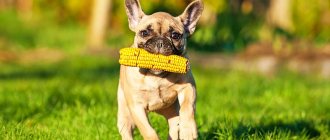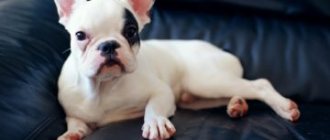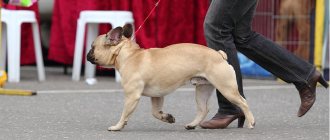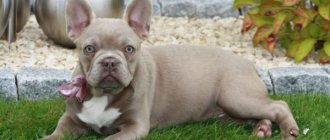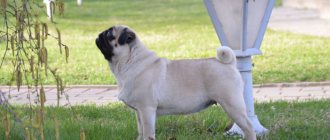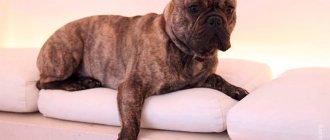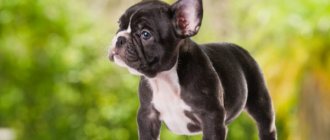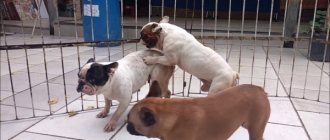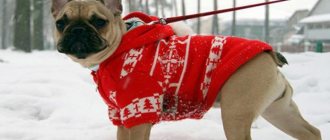Mandatory tail docking for French Bulldogs was abolished in 1992. when the member countries of the European Union adopted the Convention for the Protection of Pet Animals. In Russia, this document has not been ratified, and owners continue to cut their dogs' tails. This is often required for medical reasons. The procedure is carried out at 3 days of age.
Is a French Bulldog's tail docked?
In order to answer the question of whether French bulldogs need to have their tail docked, it is enough to read the breed standard and become familiar with the history of its origin.
All ancient dogs had long tails, but back in the era of the Roman Empire, people came up with the idea of docking, that is, cutting off this part of the dog’s body. They did this, of course, not for fun, but for practical reasons: in a fight with wolves or in gladiatorial fights between dogs, the tail was a vulnerable spot. The fighting qualities of a dog without a tail improved noticeably.
Therefore, the tradition of docking the tails of dogs of fighting breeds was firmly entrenched and continued from century to century. Modern society has become more humane, dog fighting is officially prohibited, and therefore the need for tail docking has disappeared. Moreover, a law has appeared prohibiting the tail docking of dogs, and violation of this law entails penalties and general disapproval for cruelty to animals.
The Convention for the Protection of Domestic Animals, which includes a provision banning tail docking, was adopted back in 1992 by member countries of the European Union. Russia did not sign this document, therefore in our country they continue to carry out tail docking surgery, which is performed at 3 days of age.
For puppies of small breeds, the operation can be performed in a gentle way: tie the tail in the right place with a strong thread, after which the blood circulation will be disrupted and the tail will fall off. There is a lot of controversy surrounding tail docking. Some people believe that this is a barbaric relic, and modern people should not act so inhumanely towards animals.
Others say that if docking is banned, the appearance of breeds that have lived with docked tails for centuries will be disrupted, their movement pattern and even behavior will change. Fortunately, French bulldog owners can watch these disputes from the sidelines without having to dock their pets' tails. The gene responsible for the short tail is firmly established in the breed and is inherited from generation to generation.
Most French Bulldogs are born with short tails that do not require any additional manipulation to change their length. The breed standard states that the French Bulldog's tail should be short and low set, thick at the base and tapering towards the tip.
However, the standard has an interesting caveat that a long tail extending to the hock is also allowed, but not desirable. This explanation in the standard suggests that French bulldogs with a long tail are still sometimes born. In this case, breeders have to decide a difficult question: to carry out the docking procedure or leave everything as is.
It is the breeders who need to resolve this issue, and not the future owners of the puppy, because tail docking cannot be carried out at an older age than a few days old. Of course, a French bulldog with a long tail will cause general bewilderment, since everyone is accustomed to the different appearance of this breed.
Selling such a puppy will also likely be more difficult. Although according to the standard this will not be considered a disqualifying defect for participation in exhibitions, it is clear that a long-tailed French bulldog will not become a champion. On the other hand, in ordinary life, a long tail will not cause any inconvenience or problems to its owner; on the contrary, it will become its unique feature and highlight.
But if a breeder nevertheless decides to dock a long-tailed Frenchie, he must honestly warn puppy buyers about this. Such representatives of the breed can pass on the gene for a long tail by inheritance, which will not be a very pleasant surprise if the dog was originally planned to be used in breeding work.
So, you have decided that your future dog is a Frenchie. You, of course, have read many articles and collected all the information. However, we want to tell you some facts about the breed that we think the owner of a French bulldog needs to know.
If your dog does not accept fresh meat, it is recommended to lightly pour boiling water over it. This treatment will preserve beneficial substances and eliminate the smell of blood. Don't miss out on eating the liver, kidneys, heart and udder. They contain many useful components.
If we are talking about choosing a puppy for some specific needs, you need to choose a litter not on the spot, traveling to different nurseries, but in advance, and in general, as we hinted earlier, it is better not to choose a litter, but a breeder - then everything will follow (if Of course, your choice will be correct).
For exhibitions, a long tail can be all of these and defects, but not for owners who love their babies)))))
The Frenchie is a perfect breed, I don’t dock anything according to the standard, they can have tails that are long to the hock joint, necessarily, or broken or like a screw - this is a breed characteristic, and now I’ve seen at international exhibitions oh-so-short tails - the anus is open.
Vitamins for health
For the healthy development of a dog, vitamins are necessary:
- Vitamins E, H, C. Responsible for normalizing the reproductive ability of the body, tidying up the skin and fat metabolism processes.
- Vitamin A. Promotes puppy growth, improved vision and nervous system function.
- Vitamin B9. Allows coat development, prevents anemia, increases hematopoietic processes.
- Vitamin B6. Improves protein metabolism, maintains the optimal amount of hemoglobin.
- Vitamin D. Promotes optimal bone development, takes part in phosphorus-calcium metabolism.
The bulldog's diet includes fish oil and mineral supplements added to the dog's food. With a natural diet, an additional vitamin course may be required. It is better to consult a veterinarian about the usefulness of the products.
Types of forms
Many bulldogs have naturally docked tails, meaning dogs are born with a small tail. But in a litter there may be puppies with long tails, and with tails of an unusually short, curved shape.
With age, a dog's tail practically does not change. If it is not docked, it will remain the same as at birth.
To understand which tail needs adjustment and which does not, just read the breed standards. The main requirement: the tail should be set low. If it is above the line of the back, too short or too deep, then this is considered a serious fault.
And its complete absence, shortened to one vertebra, depressed tail will lead to disqualification.
Forms that can be found in newborn bulldogs:
- Straight tail. The American standard also recognizes such options. This will not be considered a fault in the breed.
- Corkscrew. The tail is wide at the base and tapers towards the tip.
- A long tail. Some world kennel clubs do not recognize French bulldogs with bushy tails (for example, American), while others completely accept this variety in this breed. This does not affect the character of the dog and all other qualities inherent only in French bulldogs.
- Knot . Puppies are often born with curved vertebrae, as if they are bent or knotted. The standard prescribes in this case a length that is sufficient to cover the anus, and not below the hock joint. There is no need to buy this type.
A - incorrect position of the tail, all others are standard.
The operation is recommended only if the tail at a certain moment or in the potential will threaten the health of the pet.
ORIGIN: France
Date of publication of the official current standard : 11/03/2014 Purpose: Companion dog. FCI classification : Group 9. Companion and decorative dogs. Section 11. Small Molossians. No operational tests.
BRIEF HISTORICAL SKETCH : It is believed that the French bulldog, like all mastiff breeds of dogs, comes from the Molossians of Epirus and the Roman Empire and is related to the English bulldogs, Alans (the breed was bred in the Middle Ages by the Alan tribes), mastiffs and small mastiffs of France. The Bulldog we know today is the result of numerous crosses carried out by enthusiastic breeders in the poorer neighborhoods of Paris in the 1880s. In those days, bulldogs were the dogs of porters in Parisian markets, meat traders and coachmen, but soon, thanks to their special appearance and character, they managed to gain popularity among representatives of high society and artistic bohemia. The popularity of the breed grew rapidly. The first breed club was created in Paris in 1880. The first registration records date back to 1885, and the first standard appeared in 1898, when the Societe Centrale Canine (Central Canine Society) recognized the French Bulldog breed. The first dog of this breed was presented at an exhibition in 1887. Changes and additions were made to the standard in 1931, 1932 and 1948, and in 1986 it was reformulated by H.V. by HF Reant and R. Triquet (published by FCI in 1987), then in 1994 by Violette Guillon (published by FCI in 1995) and in 2012 by the Club Working Committee French Bulldog.
GENERAL APPEARANCE : Typical small size Molosser. Impressive in power for a small size, short, stocky, compact overall, with a short smooth coat, snub-nosed muzzle, erect ears and a naturally short tail. It should look like an active, intelligent dog, with very well developed muscles and strong bones. None of the articles should be exaggerated in relation to the others, so as not to disturb the harmony of the dog’s overall appearance and its movements. : The length of the body from the shoulder-scapular joint to the ischial tuberosity is slightly greater than the height of the dog at the withers. The length of the muzzle is approximately 1/6 of the total length of the head.
BEHAVIOR / TEMPERAMENT : sociable, cheerful, playful, energetic companion dog, intelligent, with possessive tendencies in character. . HEAD : should be massive, wide and fit into a square; the skin on the head forms symmetrical, moderately pronounced folds and wrinkles. CRANIAL REGION The skull is wide, almost flat between the ears, the forehead is domed. The protruding brow ridges are separated by a pronounced groove between the eyes. This furrow should not extend into the forehead area. The occipital protuberance is poorly defined. Transition from forehead to muzzle: pronounced.
FACIAL REGION OF THE SKULL: The head of the French Bulldog is characterized by shortening of the maxillary and nasal bones, as well as a slight backward slope of the lobe and bridge of the nose. The nose is slightly upturned (“snub muzzle”). Nose: black, wide, upturned; the nostrils are symmetrical and well open, directed obliquely backwards. At the same time, the tilt of the nostrils, as well as the upturning of the nose, should not impede normal nasal breathing. Muzzle: very short, wide; with concentric symmetrical folds. Lips: Thick, slightly pendulous and black. The upper and lower lips meet in the middle and completely cover the teeth. The profile of a well-developed upper lip is slightly rounded. The tongue should never be visible unless the dog is excited. Jaws/Teeth: Wide and powerful. The lower jaw protrudes forward relative to the upper and bends upward. The arch of the lower incisors is rounded. There should be no lateral displacement of the jaw or misalignment. The amount of deviation between the incisors of the upper and lower jaws is not strictly limited; the main condition: when the lips are closed, the teeth are completely closed. The incisors of the lower jaw are located in front of the upper ones. The incisors and canines are quite developed. Cheeks: Well developed. Eyes: wide open; their expressiveness is emphasized by attentive and lively expression; set low and far enough from the nose and ears; dark color; fairly large, rounded, the whites of the eyes should not be visible when the dog looks forward. The lining of the eyelids should be black. Ears: medium in size, with a wide base and rounded ends. Set high on the head, but not too close together, erect. The ears are turned forward. The skin should be thin and soft to the touch.
NECK : Short, strong , slightly arched, without dewlap, widening towards the shoulders .
French bulldog character
By nature, the French Bulldog is an affectionate, courageous, active and temperamental breed. He adores all the members of the family in which he lives, loves children very much, playing with them brings the bulldog great pleasure. He is cunning, smart, cheerful and good-natured.
The Frenchie combines the best qualities of a companion dog. Its compact size allows it to be kept in a small apartment; its cheerful disposition and devotion to its owner make it a good and devoted friend.
He will not let you get bored and sad, he perfectly senses a person’s mood, if you feel bad, he will just sit quietly next to you.
Funny photo with French bulldogs
The main role of the French bulldog is to play, entertain the owner and his guests, he is a real clown and a merry fellow. It has good watchdog abilities and is always ready to defend its owner in case of danger.
Doesn't like to be left alone for a long time, can be sad and play pranks, needs to communicate with people. He gets along well with other pets, especially if he has lived with them since childhood, but on the street he has conflicts with cats and other dogs. It lends itself well to training; it should start from puppyhood at 3-4 months.
Walking and swimming: duration, frequency and time of day
French bulldogs love walks, as they not only relieve themselves and release energy, but also communicate with the world. For an adult dog, it is enough to go outside twice a day; a puppy needs this more often. The duration of each walk is from 15 minutes.
Important: Difficult heat exchange and possible breathing problems are reasons for walking in the early morning and late evening in the heat. In winter, it is useful for French bulldogs to walk in the snow and run through shallow snowdrifts. This strengthens the muscles throughout the body.
French bulldogs swim in a unique way - their body is in an upright position. They cannot hold out for long, so bathing is only under human supervision.
The water should be warmer than 20 degrees, and it’s summer outside. French bulldogs are accustomed to water from childhood, gradually dipping their paws and immersing their body. You cannot throw a dog into a pond or force it there.
Medical indications for surgery
There are medical indications according to which the tail trimming procedure is mandatory for French bulldogs:
- The tail is a corkscrew, too small, looking like an ingrown tail. It interferes with hygienic procedures, the lack of some kind of protection will allow infection to enter the anus, and the dog can constantly get sick.
- Gangrene, trauma, and malignant neoplasms are also indications for the procedure.
It is possible to carry out the procedure without medical indications at the discretion of the owner, but it is important to remember that in some countries this is prohibited by law, and unauthorized docking will amount to disqualification of the animal from the exhibition.
In ancient times, dogs of this breed were born with long tails, and in Rome, they had this part of their body cut off so as not to have vulnerable spots during battle. This increased the dog's fighting abilities.
Caring for ears, teeth, eyes and claws
Erect ears suffer less from various diseases. However, for French bulldogs, they are wiped once every 2 weeks with cotton swabs, removing dirt and excess earwax.
From May to October, during the period of tick activity, the ears are carefully examined. Self-treatment of inflammation and redness is not recommended. Use cotton swabs carefully so as not to damage the ear.
The teeth of this breed should be strong, healthy and without signs of disease. To prevent stones, the French bulldog is allowed to chew hard vegetables and fruits (carrots, a piece of green apple), and natural veins.
The oral cavity is periodically examined by a veterinarian. In adolescents, interventions are possible to remove baby teeth and their roots if they interfere with the normal growth of the molars.
The claws often get worn down during walks, but if they interfere with movements, they are shortened with special forceps. This procedure also requires dry potassium permanganate and cotton pads. Dogs' nails contain blood vessels, so only the ends are removed.
Nippers are sometimes replaced with a manicure file with a coarse abrasive, but then the treatment is carried out regularly. If claw trimming is unsuccessful, the bleeding is cauterized with several potassium permanganate crystals, pressing them with a cotton pad.
In French Bulldogs, discharge from the eyes accumulates in the folds near the nose. The skin in this area is wiped daily with a dry cloth. The eyes of this breed are often injured due to the structural features of the skull. Their inspection is a mandatory procedure.
When is it not carried out?
By and large, there is no need to dock the tail unless there are medical indications for it. The vast majority of bulldogs are born with short tails. Standards in the modern world state that the tail should be short, low set, and does not require additional adjustments. The most interesting thing is that an unusual bulldog with a long tail will be allowed to participate in exhibitions; there is no article in the rules for disqualifying such an animal.
But such an individual may have problems in breeding; not all breeders are ready to breed long-tailed pets; nevertheless, the French bulldog has characteristic features, and a tiny tail is one of them. Therefore, the issue of docking is decided by the owner of the kennel, since after three days the puppies no longer undergo surgery unless there is a medical need.
The “long-tailed” gene is inherited, and if the breeder did not honestly warn the buyer that there was docking, in the future the new owner may be very surprised by the offspring with luxurious tails.
The operation is also not performed if the dog does not feel well, is sick, has a rash on the stomach or a hernia. When the symptoms go away, you can perform the procedure.
The history of the appearance of the French
The French Bulldog is a relatively young breed. It began to be introduced only towards the end of the nineteenth century. If we put together all the information about the breed, then, according to many experts, the ancestors of the Frenchman are English bulldogs, Spanish Alans and pugs. Perhaps this explains the external similarity of the listed breeds.
Previously, people used bulldogs for their own entertainment and organized dog fights. After all, the breed was considered a fighting breed. Even the name “bulldog” literally means “bull dog”, “bull dog”. Sometimes dogs were allowed to fight a bull (a kind of bullfight). But, fortunately, very soon such cruelty was banned, and bulldogs began to be perceived by people as domestic dogs. It is in France that the fighting dog is made into a domestic dog.
Now the French are popular literally everywhere. This funny French dog with huge ears is so friendly and sweet that it’s hard to imagine her in the fighting ring.
The procedure itself
If the breeder decides to dock, then after contacting a veterinarian, one of two methods of surgical intervention will be chosen: compression and cutting off. The first option is considered more humane. The tail is tied with a tourniquet along the docking line, or a tight elastic band is applied. The goal is to cut off blood circulation for a period of two days to a week. After this period, part of the tail dies and falls off. In the second case, the doctor trims the tip of the tail; at three days of age, the cartilage easily gives way. There are a number of rules for the procedure:
- Before surgery, you need to measure the dog's temperature. The norm is 37 - 39.5 degrees. If the animal's temperature is higher, then an infection is likely, and the operation is postponed.
- Before docking, the puppy is not fed for 12 hours.
- The tail can only be cut off with special surgical scissors or a scalpel.
- The area around the tail is shaved and disinfected (5 and 10% iodine solution, medical alcohol).
- The skin is pulled back to the base, and excess vertebrae are cut off in the selected area.
- After circumcision, the wound is treated with iodine, the skin is returned to its place and a pocket is formed, and a couple of stitches are placed on it.
- The wound is disinfected and treated with an antibiotic.
- The stitches can be removed after about a week.
If a puppy's tail is docked at three days of age, no anesthesia is used; the dog is held by hand. If the animal is older, then painkillers are used, for example, Lidocaine. With age, it will be more difficult for your animal to undergo surgery. For example, bulldogs that have reached the age of one month must be securely fixed on the surgical table, securing the jaw.
And adult dogs are docked only under general anesthesia. The method of inhalation of ethereal alcohol-chloroform with neuroplegic is used. A vagolytic is administered intravenously to reduce salivation and secretion of the tracheal mucosa. This will prevent them from entering the respiratory tract. The operation is the same as for puppies. A sterile bandage is attached to the wound.
During the postoperative period, it is necessary to carefully monitor the condition of the sutures. If they separate or bleed, the wound needs to be treated; if symptoms recur, contact a veterinarian.
Serious disadvantages
Among the serious disadvantages of dogs of the French Bulldog breed, the following are most often noted:
- muzzle too long or short;
- when the mouth is closed, the tongue is visible;
- light colored eyes;
- horizontal top line from withers to loin;
- too intense weakening of the color of the lips, nose, edging of the eyelids, which should not be completely depigmented;
- straight bite.
Return to content
Aftercare
If the tail is cut off on a tiny puppy, the wound will heal quickly.
In this case, special care is not needed.
But it is better to keep puppies separate from their mother, bringing them for food.
This is necessary to prevent the dog from licking the wound at the docking site.
For the bed, disposable multi-layer diapers are used. Light ones are better, because they will be noticeable if the wound starts to bleed. Then you need to treat the area with hydrogen peroxide. If the operation was performed under general anesthesia, then the animal must be monitored for two to three hours.
Consequences may include vomiting, convulsions and trembling. Then you need to put the dog on its side, cover it, monitor its condition, put a bowl of water next to it - the dog will be thirsty. If the healing process goes well, the sutures are removed after two weeks. The owner must constantly monitor the condition of the stump and treat the wound, disinfecting it. If there is blood, inflammation, or fever, you should contact a veterinarian. It is also recommended to put a special “Catherine’s” collar on the dog; it will prevent the wound from being licked and getting infected in this way.
Nutrition
The French Bulldog's menu should contain all the essential nutrients for dogs. If a particular animal has certain characteristics or health problems, then this should definitely be taken into account when choosing food. Eating a nutritious and balanced diet of good quality can not only prolong your pet's life, but also allow him to look better and be more active and cheerful.
Dry food is the best choice for French Bulldog owners who don't want to waste time preparing "homemade dinners." In addition, industrial food can not only make the life of dog owners easier. It is healthy and balanced. Properly selected food can relieve your pet of problems such as allergic reactions, problems with the gastrointestinal tract and many others. Good commercial food contains all the necessary vitamins and minerals, so you don’t have to give them to your dog separately.
Since French bulldogs are prone to obesity, food should be selected with a low fat content. Also, these breeds suffer from gastrointestinal problems, so it is important to choose a good quality diet without skimping on it.
On sale you can find food for French bulldogs of various classes:
- Economy Such feeds contain low quality ingredients, and there is practically no natural meat, vitamins and minerals. But there are an abundance of flavorings;
- Premium These diets partially contain meat, but most of the composition is taken up by offal;
- Super premium. This diet includes pure natural meat, it should be at least half of the total mass. As additives there is a complex of vitamins and minerals;
- Holistic. The quality of these feeds is so high that manufacturers are confident that even people can eat the granules.
For French bulldogs, as breeds prone to allergic reactions and indigestion, feeding on economy-class food is simply contraindicated. If you cannot provide your pet with good nutrition, then it is better to hold off on getting a dog. If for some reason at the moment you cannot feed your dog a premium diet or higher, then be sure to give him vitamins and minerals, supplements to normalize the microflora of the gastrointestinal tract. The quality of food is especially important if the dog is at an “advanced” age.
To calculate the amount of feed, follow the tips that each manufacturer indicates in the form of a table on the packaging. If you want to combine wet and dry food, it is better to give preference to one brand.
Limbs
FOREQUARTERS: General appearance: Set up vertically and straight when viewed from the side and front. Shoulders: obliquely set. Shoulder bones: massive, muscular, slightly curved. Elbows: located close to the body. Forearms: Short, straight and muscular Carpal joints (wrist): Short, not prominent. Pasterns: Short, slightly sloping in profile. Forelegs: round, compact, small, so-called “cat-like”, slightly turned outward. The fingers are tightly closed, the claws are short, thick, black.
HINDQUARTERS: General appearance: The hindquarters are strong and muscular, slightly longer than the forelimbs, which causes the sacrum to rise relative to the withers. Almost vertically set when viewed from both the side and rear. Hips: well-developed muscles, strong. Hocks: Set rather low, the hock angle is not too pronounced, but not straightened either. Tarsus: strong. Hocks: short. Hind feet: Round, compact, turned neither in nor out. MOVEMENT: The limbs move parallel to the longitudinal axis of the body, both when viewed from the front and from the side. Movements are free, powerful, smooth.
SKIN : Thick HAIR: Coat: short and smooth, close-lying, shiny and soft, without undercoat. Color: from light fawn to red, with or without brindle, with or without white spots. Solid Coat: Brindle: Light fawn to red coat with moderate dark brindles; with frequent brindling, the stripes should not completely cover the main color. A black mask is possible. Limited, small white markings are acceptable. Light Fawn to Red: Solid colors range from light fawn to red, with or without a black mask, but a black mask is preferred. Sometimes a lighter color is observed on the lower part of the body and limbs. There are small white markings. Coat with white spots: Brindle with moderate to significant amounts of white spots: Ideally, the white spots are distributed throughout the body. Light markings on the skin are acceptable. Color ranges from light fawn to red with moderate to significant amounts of white spots: Ideally, white spots are distributed throughout the body. Light markings on the skin are acceptable. The nose is always black in all colors, never brown or blue. A completely white color with a black eyelid rim and a black nose is acceptable, but such individuals are not used for breeding due to the risk of producing deaf offspring.
HEIGHT AND WEIGHT : Height at withers: males 27-35 cm, females 24-32 cm, deviations of 1 cm upward or downward from the indicated limits are allowed.
Weight : males from 9 kg to 14 kg; bitches from 8 kg to 13 kg. Exceeding the weight by 500 g is allowed provided that the breed type is maintained.
FAULTS: Any deviation from the above parameters should be considered a fault and assessed according to its severity and effect on the health and welfare of the dog.
- Intense speckling on the coat in brindle color with white spots;
- Intense speckling on the coat with a color ranging from light fawn to red with white spots;
- With a color ranging from light fawn to red, there is a wide black stripe along the spine;
- With any solid color - white markings on the paws;
- Light claws.
SERIOUS DISADVANTAGES:
- Exaggerated type, exaggerated breed characteristics;
- Muzzle is too long or too short;
- The tongue is visible when the mouth is closed;
- Light eyes (light eyes of a bird of prey).
- Horizontal top line from withers to loin;
- There is a more intense weakening of the pigment of the lips, nose, and rims of the eyelids, which should never be completely depigmented.
- Direct bite.
DISQUALIFYING FAULTS:
- Aggressive or cowardly behavior;
- Any dog with obvious physical or behavioral abnormalities must be disqualified;
- Lack of breed type, making the dog atypical for the breed;
- Completely closed nostrils;
- Jaw misalignment or lateral displacement of the jaw, which makes the tongue constantly visible;
- Dogs with the lower incisors located behind the upper incisors (scissor bite);
- Dogs whose fangs are constantly visible when their jaws are closed; discord;
- Nose any color except black;
- Erect ears;
- Lack of tail or ingrown tail;
- Dewclaws on the hind legs;
- Non-locking hock joints;
- Long, harsh, wiry or plump coat;
- Inappropriate coloration, namely black, black with tan markings (black and tan), and any dilution of the black color with or without white spots.
- Height and weight outside the limits specified in the standard;
- Dogs with difficulty breathing;
- Deafness.
ICF standard (RKF)
This is one of the largest organizations in Eastern Europe. It has its own rules. The FCI (International Canine Federation) standard includes a description:
- Physique;
- Color;
- Type and structure of wool;
- Color of eyes, nose, claws, mucous membranes;
- Ears and tail;
- Movements;
- Character;
- Vices, shortcomings.
At the beginning of the standard there is a short story with important dates about the formation of the breed and its ancestors. The purpose of French bulldogs and the need for working tests are also indicated.
They were assigned to group 9 as indoor and decorative dogs. Next to them are pugs, Pekingese, Chihuahuas, Shih Tzus, poodles, and Maltese. Operational tests are not provided.
Important: The current version of the ICF standard was published on November 3, 2014. All changes in it are highlighted.
